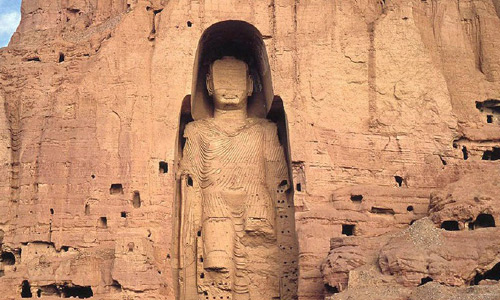Although political and security issues have been reiterated in the US-Taliban peace agreement, signed in the Qatari capital of Doha, politics and security are not the only factors for the establishment of sustainable peace in the society. Additionally, the agreement by leaders and involved parties in conflict as well as social, cultural, economic, mental and historical grounds will lead to sustainable peace.
This month, as ensued by the US-Taliban peace agreement, is critical for reviewing the Taliban’s records. The Taliban were directly involved in shocking events occurred this month. On 26 February 2001, the Taliban council of leadership, Ulema council, and Supreme Court, with Mullah Mohammad Omar at the helm, issued a decree to destroy all ancient monuments of Afghanistan. In light of the decree, a large segment of the country’s ancient artifacts were left at the mercy of destruction and the Taliban group blew up and demolished the Buddha Statues, Salsal and Shamama, in Bamyan province, which were one of the seven world wonders. To destroy the statues, the Taliban initially fired at the Buddhas with tanks and artillery shells and then planted explosives, which led to the annihilation of the two statues.
It came as a number of states and international organizations including the UNICEF, tried to persuade the Taliban not to resort to the destruction of Buddhas, however, their struggles were proved ineffective. The Taliban were not only involved in the war against Afghanistan’s archaeological monuments but also against world history intending to abolish Afghanistan’s great ancient relics, which carry the world history in them.
The Taliban’s destruction of Buddha statues is likely to be accounted a cultural crime and an inhuman act, and Afghans may hold a view that the past should be forgotten. However, their acts of crime led to the destruction of the Buddhas, and the fear of repetition should be considered. The Taliban’s rule system is based on emirate, in which emir, the clergy, and the elders play crucial role in decision-making. The worst, the emir, known as “Emir-ul-Mumineen” (the commander of the faithful), exercises the authority to issue fatwa against a group, cultural relics, ethnic folks, residents of a particular area, sects, etc., as it was done for the destruction of Buddha statues. Ill-fatedly, Afghanistan’s history is replete with such fatwas (religious decrees) issued leading to the massacre of millions of people, destruction of territories, and migrations and captures of many more millions.
Few years back, however, this scenario was repeated in other geographical parts of the world, which was the reminiscent of the Taliban’s acts carried out against Afghanistan’s culture and history. The historical and archeological monuments of Iraq and Syria were also left at the mercy of destruction with the emergence of the self-styled ISIS group. Entering a city, the first targets of the ISIS group were historical heritages and ancient relics, museums, shrines, sacred places, and public infrastructures.
UNISCO reported that the ISIS group had bulldozed Nimrud, an Assyrian city from the 13th century BC, Hatra, and Mosul Museum in Iraq. Moreover, the group also demolished historical and ancient artifacts in Syrian cities such as Idleb, Dar’a, Tadmur, Hama, Temple of Bel, tombs, historical shrines, and Monumental Arch.
During the ISIS’s war in Syria and Iraq, Dabiq, an online ISIS magazine, outlining the motivation of the group for demolishing ancient monuments, claimed that the enemies of the ISIS were enraged for missing a valuable heritage. It added that the infidels discovered the statues and remnants of the past generations and sought to portray them as a part of an identity and cultural heritage.
The campaigns of religious fundamental groups such as the Taliban, al-Qaeda, and ISIS, against ancient and historical artifacts are alike in many cases. The similarities mostly originate from their ideological beliefs. They all viewed ancient monuments as symbols of infidelity and showed particular interests to demolish them. That is, they all deem themselves to play the role of idol-breaking Abraham, and seek to destroy whatever irreconcilable with their wills and beliefs so that they could portray themselves the true faithful and pious to their followers.
Anyway, the Afghan government and the Taliban seek to start peace negotiations in the coming days and the international community seems pleased with it. At this juncture, it is recommend that the Taliban’s acts and practices have to be viewed so that it could be clear whether or not the Taliban have changed their perspective regarding social life and some priorities in urban life.
Home » Opinion » Demolition of Buddhas – Reminiscing Taliban’s Acts vis-à-vis Culture and History
Demolition of Buddhas – Reminiscing Taliban’s Acts vis-à-vis Culture and History
| Moh. Reza Huwaida

